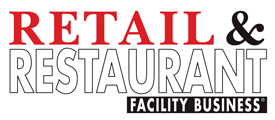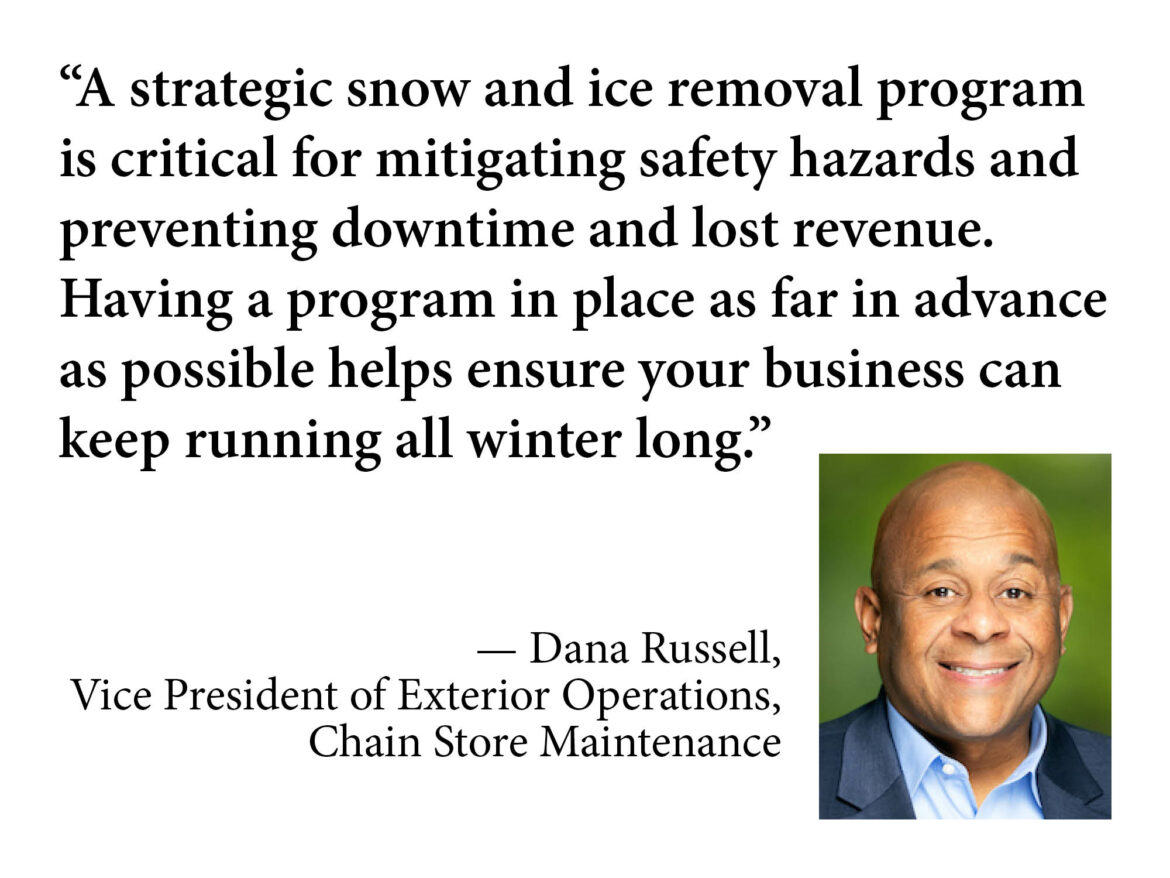For restaurants and retailers, customer service doesn’t stop at the front door. It extends to the sidewalks and parking lots. During the winter months, prompt snow and ice clearing is essential for ensuring guest safety and maintaining smooth business operations.
“A strategic snow and ice removal program is critical for mitigating safety hazards and preventing downtime and lost revenue,” says Dana Russell, vice president of exterior operations at MCS & Chain Store Maintenance. “Having a program in place as far in advance as possible helps ensure your business can keep running all winter long.” That preparation should begin in the summer months for best results.
Every restaurant and retailer has its own specific snow and ice removal needs, but there are a few universal considerations that can help you make sure your properties stay open and well maintained and that your employees and customers are safe this winter. Here are eight considerations when building your snow removal program.
1. Be Strategic with Your Snow Program Timeline
Your snow and ice removal request for proposal (RFP) should be completed months before the first snowfall. This helps you secure the best service providers in your area. “Aim to send out your RFP in early to mid-summer,” Russell says. “Then, try to select your provider by early September, kick off your program in October and wrap it up with a post-season inspection in early spring.”
2. Set Clear Expectations in Your RFP
In your RFP, clearly communicate your level-of-service expectations, including the services you want completed, how you want them completed and related requirements like specific equipment or products that should be used or avoided.
Your RFP should include detailed site maps that clearly identify the following:
- Areas to be cleared of snow
- Areas maintained by the city or covered under common area maintenance
- Designated snow storage areas
In addition, your snow removal partner should know exactly which areas are the most important to cover if there’s a severe storm or other potential challenges. Be sure they know which parking lots, sidewalks, driveways or loading docks to clear first.
And your RFP should include details on the times when service will need to be completed to ensure safe access for customers and employees.
3. Clear Communication and Reporting
Communication and reporting are essential during the snow season. Make sure your provider can meet your expectations, including documenting and communicating essentials like service start and stop times, services performed (via photo documentation) and site weather conditions.
“Your provider should also understand the importance of dependable pre-storm communications to keep you up to date on the latest weather conditions and actions being taken,” Russell says. “Chain Store Maintenance, an MCS Company, uses WeatherWorks, AccuWeather and other meteorological data to help forecast snow accumulation over 24-, 48- and 72-hour periods when a storm is approaching, and we share pertinent details and related potential impact with our clients through ongoing updates.”
4. Ask about Technology Platforms
Ensure your systems can integrate with your service partner’s technology platform. “You’ll want to confirm this before the snow season begins,” Russell says. “Chain Store & MCS can connect with platforms like ServiceChannel, ServiceNow, Fexa, EcoTrax, Officetrax, FacilitySource, ServiceChannel and Corrigo, or you can use MCS’s technology platform.”
5. Check for Liability Coverage
Confirm that your provider carries the necessary liability insurance. This ensures you’re protected against risks such as slip-and-fall claims and property damage caused by snow and ice removal.
6. Find a Pricing Structure that Works for Your Business
Because every business has varied snow removal needs, there are multiple ways to price it that you’ll want to consider as well, including the following:
- Pricing per occurrence/push: Your provider services your site based on a set trigger (one or two inches of accumulation, for example) once accumulation begins and for as many times as the trigger is met, and you’re charged on a per-occurrence basis.
- Seasonal pricing: The first day of your snow removal contract marks the first day of the season, and your fixed-fee services usually include plowing, shoveling and deicing. Seasonal contracts are typically multi-year and are well-suited to areas with higher-than-average snowfall.
- Time and materials-based pricing: Larger commercial properties that require specialized equipment gravitate toward this option, which is priced by the hour and can be customized based on the equipment and methods used.
7. Plan for a Preseason Rollout and Postseason Wrap-Up
A preseason rollout inspection with your snow removal partner gives you a chance to review and confirm the areas that need to be staked and maintained based on the site map you shared and where the snow will be pushed.
“This rollout can be especially vital for businesses in areas where snow is heavy and consistent, because more damage will naturally occur throughout a snow season,” Russell says. “During this visit, we also check for existing damage for comparison at the end of the season.”
A postseason inspection can also be helpful to review how your snow program went overall and cover potential adjustments or improvements for next year.
8. Request Credentials
To ensure a safe and well-managed snow and ice management process, work with an experienced and proven team that has Certified Snow Professionals (CSP) on staff. This certification validates a provider’s ability to safely manage snow removal and demonstrates they are armed with the right tools and knowledge for the job.
With proper planning, clear expectations and strong communication, your snow and ice removal program can run smoothly all season long.
More Best Practices for Snow and Ice Removal
Experienced commercial facility managers know that early planning is key to a successful snow and ice removal program. In this complimentary eBook, you’ll learn what steps to take before winter begins, how to stay vigilant throughout the season and how to assess your efforts once it ends. With expert insights and practical tips, you’ll be prepared to handle whatever the snow season brings.
Chain Store Maintenance, an MCS Company, is a content partner of Retail & Restaurant Facility Business. For more content partner articles, click here.

